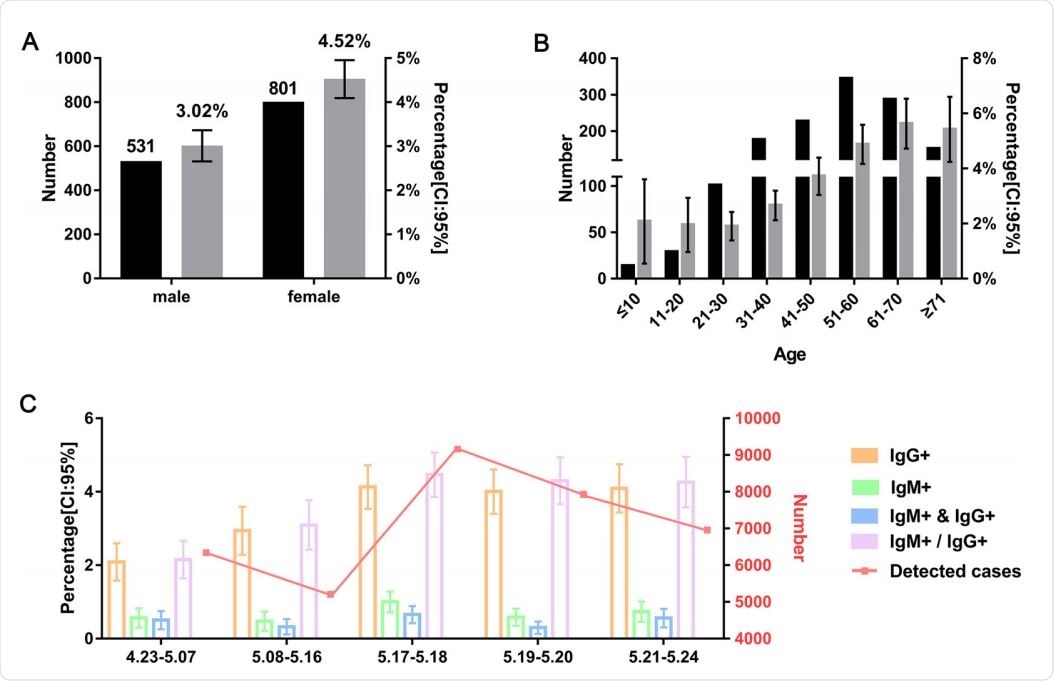Study focuses on SARS-CoV-2 antibody seroprevalence in Wuhan and COVID-19 controls
Since the emergence in December 2019 in Wuhan, China, severe acute respiratory syndrome coronavirus 2 (SARS-CoV-2) has spread worldwide via transmission among close human contacts. Early on, several public health interventions were implemented in Wuhan city and Hubei Province, including lockdowns, social distancing, traffic restrictions, stay-at-home policies, face mask requirements, building temporary hospitals, and centralized quarantine. There were 50,355 confirmed cases of SARS-CoV-2 infection in Wuhan as of 28 January 2021.
According to a modeling study, the travel restrictions in Wuhan delayed the progression of the epidemic by 3 to 5 days in mainland China. They decreased international importations of SARS-CoV-2 by 80% through mid-February. The multifaceted public health interventions were associated with increased control of the COVID-19 outbreak in Wuhan city.
The study also showed that measures such as social distancing reduced transmission of severe acute respiratory syndrome coronavirus 2 (SARS-CoV-2) and mitigated COVID-19 burden in Singapore and China. However, the study determined COVID-19 cases based on the detection of SARS-CoV-2 RNA in symptomatic patients and ignored large numbers of recovered symptomatic patients who did not get tested and asymptomatic patients.
.jpg)
Determining the cumulative incidence of SARS-CoV-2 infection in Wuhan using serologic tests
Researchers from China recently conducted serologic tests on 35,326 individuals to assess the cumulative incidence of SARS-CoV-2 infection in Wuhan city. The individuals in the study belonged to 4 different communities. The study is published in mSphere, an open-access journal published by the American Society for Microbiology.
The study results showed that 1,332 individuals (3.77%) tested positive for COVID-19 antibody – either Immunoglobulin M (IgM) or Immunoglobulin G (IgG). Males were found to have a lower positivity rate compared to females (3.02% vs. 4.52%). There was a clear increasing trend in antibody positivity rates based on patients’ ages and positivity varied across different communities. The findings indicate that public health measures may play a significant role in controlling SARS-CoV-2 transmission.
“Of note, the overall positive rate in Wuhan is lower than what was reported in other regions, like Spain (3.77% versus 5.0% to ∼6.2%) and Geneva, Switzerland (3.77% versus 10.8%).”
Study shows asymptomatic patients can have a greater risk of virus transmission than symptomatic patients
This study revealed that there is a higher prevalence rate of SARS-CoV-2 antibodies in the elderly population. Older adults are more likely to have comorbid conditions that may increase the severity of COVID-19 disease. Since asymptomatic patients do not have clinical symptoms, diagnosis and treatment can be delayed, and they may have a greater risk of virus transmission compared to symptomatic patients. This poses a massive challenge to infection control.

Reported cases in Wuhan were lesser than the actual infections due to asymptomatic COVID-19 infections
The findings of this study offer important data for the assessment of the status of the COVID-19 epidemic in the initial epicenter of Wuhan, China. About 3.77% of Wuhan’s population had detectable antibodies against the SARS-CoV-2 virus at the end of the first wave of the COVID-19 pandemic. According to the study results, the number of reported cases was lesser than the actual number of infections, likely due to many asymptomatic COVID-19 infections.
“Our detection of a relatively high proportion of IgM-positive individuals at a time when only 7 cases were confirmed by reverse transcription-PCR (RT-PCR) testing may suggest that asymptomatic virus transmission was continuing, undetected, in these communities.”
The results show that the widely used symptom-based screening strategy is insufficient to detect a significant percentage of potentially infectious COVID-19 cases and control the transmission of the virus. The authors mentioned that, although it is costly and time-consuming, a “pooled testing” strategy that tests all residents could be considered to screen several residents at once.
“Beyond the current phase of the pandemic, it may be necessary to proceed with a cautious approach in reopening businesses in areas of epidemicity to prevent potential future waves of COVID-19.”
- SARS-CoV-2 Antibody Seroprevalence in Wuhan, China, from 23 April to 24 May 2020 Huan Han, Junzhu Yi, Gongbo Cheng, Wuhui Jiang, Grzegorz M. Brożek, Yingan Jiang, Chengliang Zhu, Yuchen Xia mSphere Apr 2021, 6 (2) e01062-20; DOI: 10.1128/mSphere.01062-20, https://msphere.asm.org/content/6/2/e01062-20
Posted in: Medical Research News | Disease/Infection News
Tags: Antibodies, Antibody, Coronavirus, Coronavirus Disease COVID-19, Immunoglobulin, Infection Control, Microbiology, Pandemic, Public Health, Respiratory, RNA, SARS, SARS-CoV-2, Severe Acute Respiratory, Severe Acute Respiratory Syndrome, Syndrome, Transcription, Virus

Written by
Susha Cheriyedath
Susha has a Bachelor of Science (B.Sc.) degree in Chemistry and Master of Science (M.Sc) degree in Biochemistry from the University of Calicut, India. She always had a keen interest in medical and health science. As part of her masters degree, she specialized in Biochemistry, with an emphasis on Microbiology, Physiology, Biotechnology, and Nutrition. In her spare time, she loves to cook up a storm in the kitchen with her super-messy baking experiments.
Source: Read Full Article



